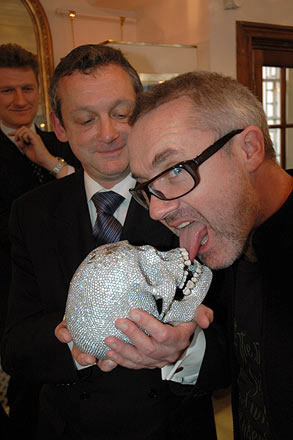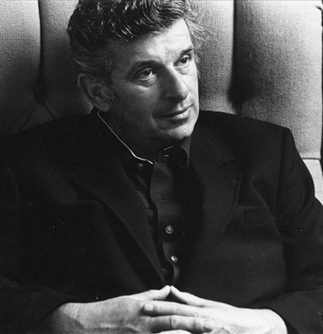

Who are we kidding -- we have no culture. Don't get me wrong, there is a cultural force in America that produces painting, cinema, music, and literature. But in no sense is it ours. Culture today is owned, operated and, in the final analysis, enforced by a profit structure. All things equal (to speak in native economic terms), this shouldn't be a problem. Art needs money, creators of culture also have to eat. But today, the wealthy and powerful no longer fund art and culture; they invest in it. And they expect their returns.
Call it the Damien Hirst Effect. Hirst is the British "artist" whose crowning masterpiece was a skull he studded with diamonds, and then sold -- to an investment firm -- for more than $100 million. Actually, Hirst didn't make the skull himself, as he runs a factory of workers who do the work for him. The diamond-studded skull, more manufactured than made, ended up as part of a series of pieces that netted the "artist" more than $230 million dollars -- in one year.
In this way, Damien Hirst became one of contemporary culture's "great artists," earning him magazine covers and invoiced praise as hollow as the man's skull (diamond-studded and otherwise). In case we think that Hirst is just an anomaly, think again: fellow "artist," Jeff Koons, sold similar dross for eight and nine-figure sums. Furthermore, Universal, Warner Brothers, Paramount and the other big studios that, once upon a time, funded young and daring artists like Robert Altman and Woody Allen, are now basically cold-blooded cinematic hedge funds (could the recent Conan O'Brien flap at Universal-owned NBC have made this point any better?). And, of course, the flailing, fumbling behemoth called the music industry prosecutes any miniscule, unlicensed peep of their property to the last penny -- for lack of a better business plan.
It's a culture not of excess (many excessive cultures churned out world-altering art), but of waste. While we're panicked about producing too much carbon dioxide and trash, we're standing by and watching as a run-amock-industry gleefully destroys our own cultural environment. Why should we think this cultural self-destruction is any less irreversible than the natural kind?
To understand the situation fully, we have to also look at the other side -- people producing works of art and culture with passion, heedless of monetary return, uncaring about the praise or opinion of the corporate-culture elite. It's hard to find these examples, not because they don't exist, but because they're buried by rights issues, distribution embargoes and a simple, profound apathy.
One example I can pull from my personal experience encapsulates all these issues, maybe to a painful degree. "Sid Bernstein Presents...," which I saw at a rough-cut screening, is a documentary by filmmakers Evan Strome and Jason Ressler. Its subject is Sid Bernstein, probably the single greatest influence on pop and rock 'n roll culture of the 20th Century. Why don't I know who Sid is, you ask?
Good question. Sid Bernstein literally brought The Beatles to America. He called them up after reading about their performances in the UK and arranged for them to play for the first time in the US. He did the same for The Rolling Stones, The Kinks, Herman's Hermits, The Animals, The Moody Blues and pretty much the rest of the British Invasion. He invented the outdoor stadium concert, with The Beatles' Shea Stadium performance, as well as the concept of the charity benefit concert (sorry, Bob Geldof).

As James Brown's promoter, Sid Bernstein organized many of America's first mixed-race music performances. He promoted to fame Tito Puente, as well as many of the other Latin pioneers of the mambo period. He gave Quincy Jones his first break, putting him in the Newport Jazz Festival; he discovered Abba in Sweden, and brought them to America; did concerts with Elvis, Jimmy Hendrix and Sinatra; and was promoting the likes of Duke Ellington, Ray Charles, Sam Cooke, Fats Domino, and Tony Bennett when they were all unknowns, and, shattered racist taboos by bringing the African-American and Latino musicians to what had until then been "whites-only" venues.
And it's not just the music historians who credit Bernstein. The film, Sid Bernstein Presents... , captures James Brown saying -- in his last filmed interview before his death -- that: "Sid was doing what the Kennedys and Martin Luther King discovered later, but Sid had already begun to do it through music."
So now the question, "Why don't I know who this is?" might resonate more sharply. And here's one part of the answer: Sid Bernstein has been passed over by the Rock and Roll Hall of Fame for decades. Why? Well, put it this way: according to numerous reports, the owner of Rolling Stone magazine, Jann Wenner, who controls the Hall of Fame singlehandedly, had himself inducted instead. He also threw out the Hall of Fame committee's vote to induct The Dave Clark Five, one of the British Invasion bands Sid Bernstein promoted, and installed Grandmaster Flash in their place.
The film, Sid Bernstein Presents..., has been similarly boxed-out of the entertainment establishment by cronyism and cultural profiteering. The film tells a history that Wenner and his ilk have craftily revised. And as a documentary film without corporate backing (and, ipso facto, corporate control), the film can't be rammed through the distribution process by marketing execs and then dumped into the entertainment industry's feeding trough.
Of course, there's more: Damien Hirst might be free to violate what was once considered the sanctity of human remains (and get paid 100 million dollars for it), but filmmakers Ressler and Strome are shut down for showing historical clips and using music, in a historical manner, of rock 'n roll history. So much for so-called "fair use."
Not only have we collectively foreclosed on our own culture, but, it seems, our history has been sold off as well -- and none of us, the people on the street, have benefited from a single red cent. But the money issue misses the point, and this is exactly why we're neck-deep in cultural debt.
Had Paul McCartney and John Lennon come out to say in 1965 that they're in it for the money, they would have been met with a stadium full of blank stares. Today, however, we cheer the number-crunching cultural creator. Bling is our ethos, diamond "ice" is the mark of artistic achievement. And we happily accept the routine silencing of cultural dissent -- as it's embodied by the great man of music himself.
Sid Bernstein is still alive at 91, still promoting little-known musicians, and still ignored by the music industry of which he is a bona fide Founding Father. The man has endured appalling financial troubles, mostly because it never occurred to him that "owning" footage of a major historical-cultural event, like the Shea Stadium concert he produced, could possibly be a good thing for the world, for music, or for culture. So, Sid Bernstein is left without the bright shiny prizes -- the cars, the money, the fame, the 100 million dollar diamond-studded skull. Sid Bernstein is left with his family, his financial hardship, and his massive contribution to art and music. For Sid, whom I once had the honor of meeting, this is enough.
Today, Sid Bernstein is still sidelined by "interests," and the biopic that reveals a true history of the musical culture he helped forge is still being squashed under endless tonnage of corporate weight. With technology finally bringing the power of media to our individual fingertips, it's time we take back what is rightfully ours, correct the historical record, reset our values, and deliver the honorific of "culture" to the truly deserving.